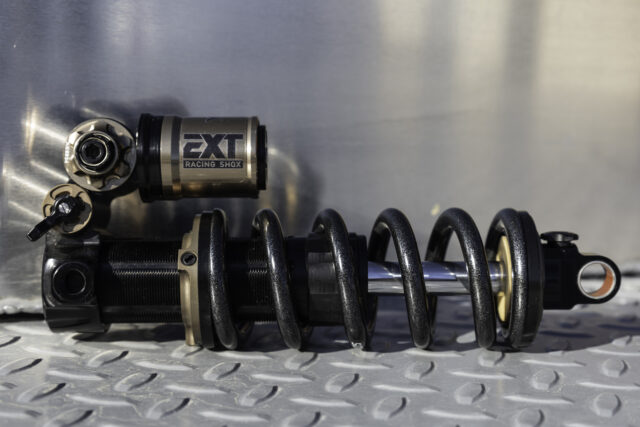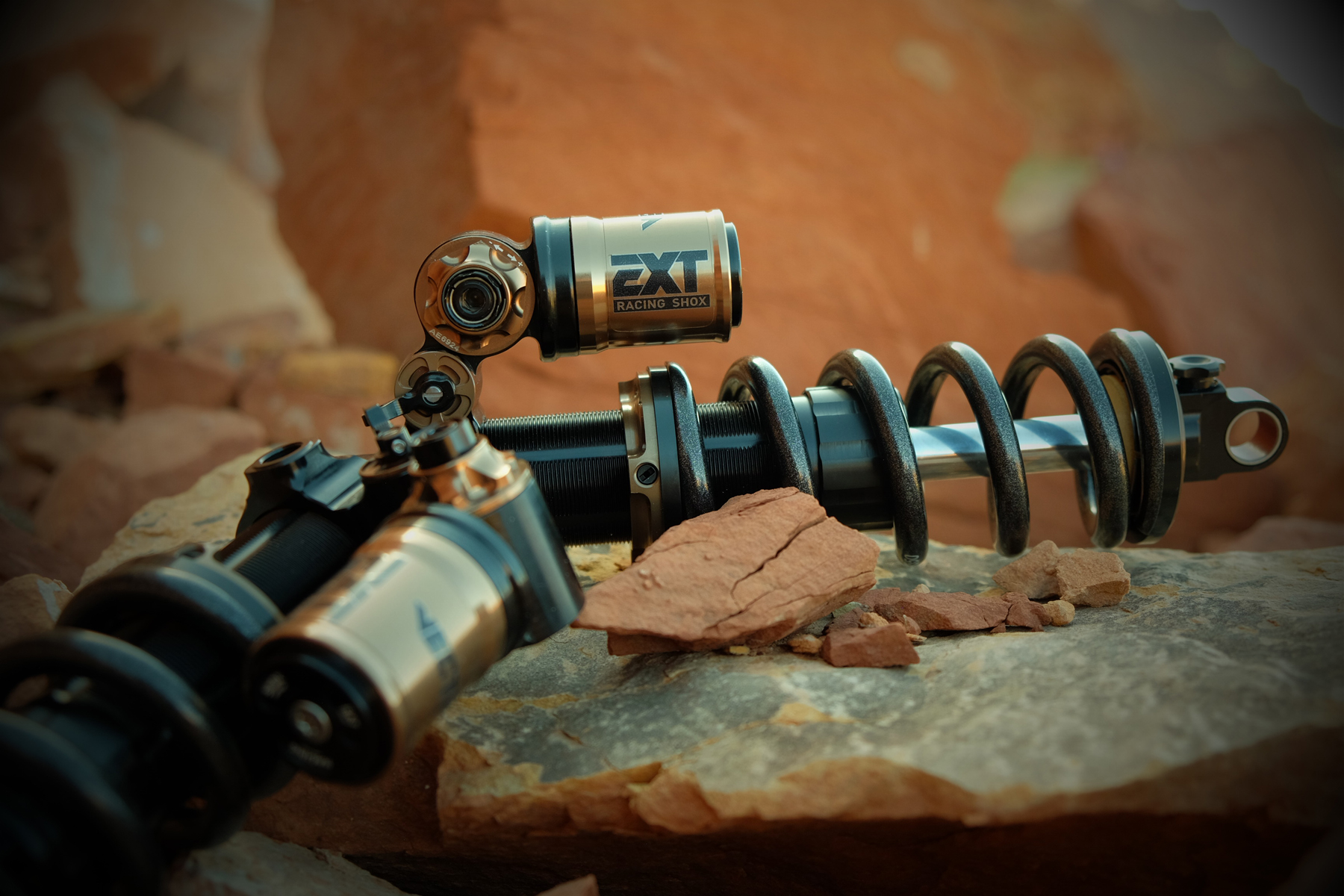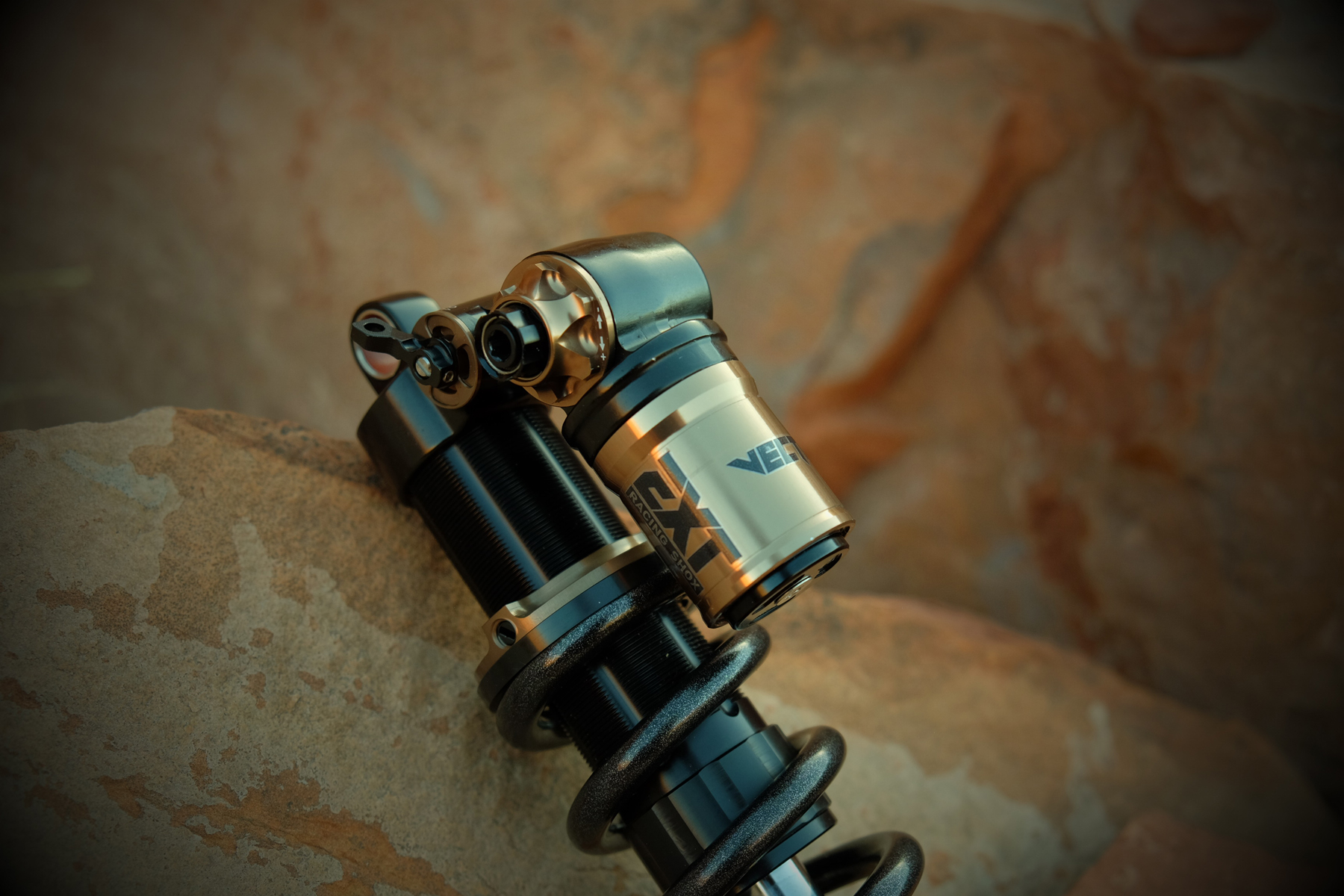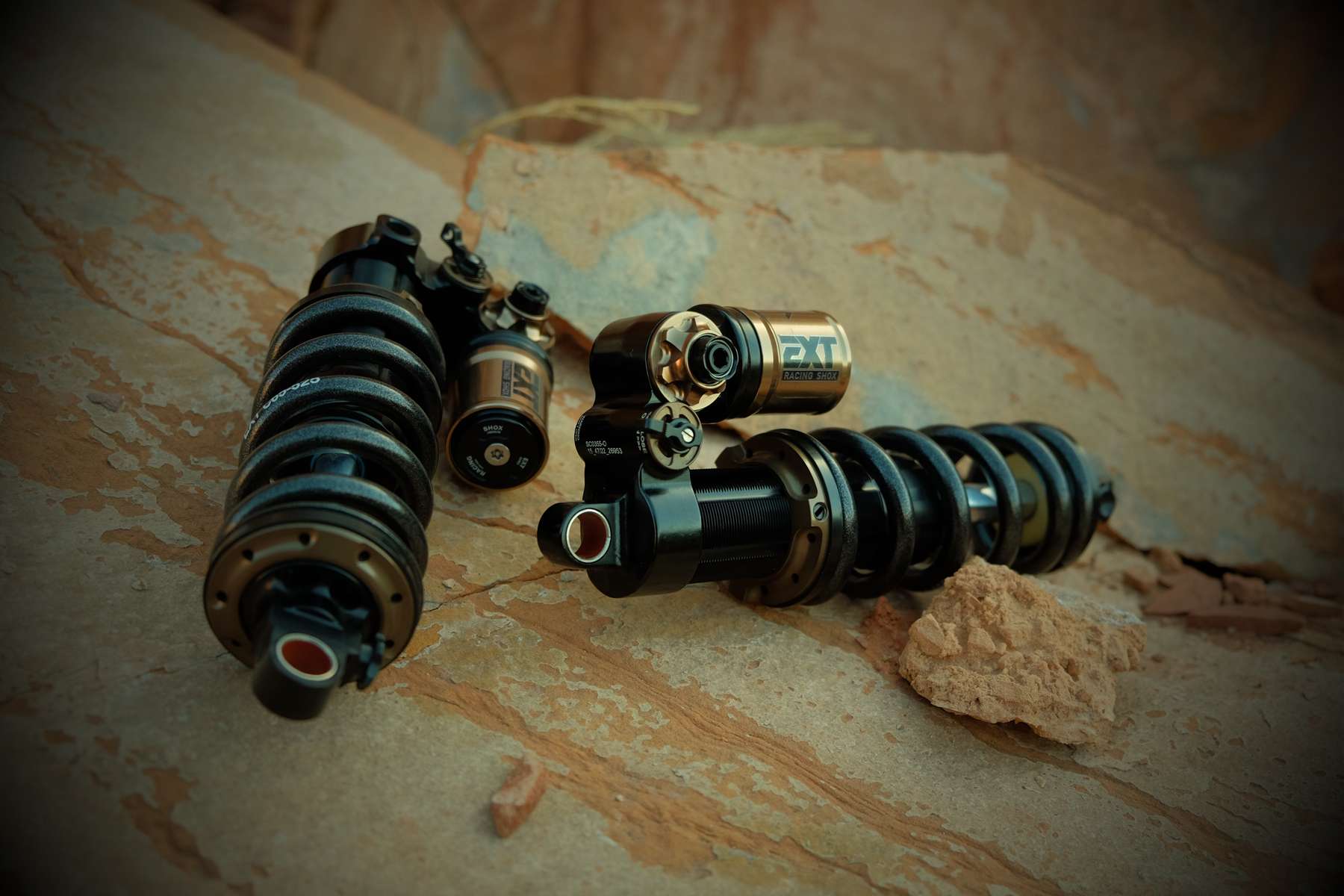EXT Vecta
MSRP: $775 / €749 (including VAT, w/o spring)
Adjustments: Rebound, high- and low-speed compression, climb switch
Sizes Offered:
- Metric:
- 210 x 50 / 52.5 / 55 mm
- 230 x 57.5 / 60 / 62.5 / 65 mm
- 250 x 67.5 / 70 / 72.5 / 75 mm
- Metric Trunnion:
- 185 x 50 / 52.5 / 55 mm
- 205 x 57.5 / 60 / 62.5 / 65 mm
- 225 x 67.5 / 70 / 72.5 / 75 mm
Blister’s Measured Weight:
- Vecta Damper: 488 g (185 x 55mm Trunnion mount)
- 450 lb/in Spring: 291 g
- 475 lb/in Spring: 284 g
Reviewer: 6′, 160 lb / 183 cm, 73.6 kg
Bolted To: We Are One Arrival 152
Test Duration: 3.5 months
Test Locations: Washington, British Columbia

Intro
EXT got its start in the high-end motorsports world and has carried that ethos into its mountain bike offerings, making a range of high-end, high-performance shocks and (more recently) forks.
Their new Vecta coil shock isn’t inexpensive, but it’s a lot more affordable than the flagship Storia and Arma V4 dampers, and it still offers most of the same features and promises similar performance. So, how has EXT done it?
We’ve got a Vecta on the way for review and will start spending time on it very soon, but in the meantime, let’s check out the details of this new Trail / Enduro shock.
Design
The high-level design details of the Vecta are largely similar to those of the Storia V4, which is EXT’s flagship Trail / Enduro shock.
The Vecta is coil-sprung and uses a monotube damper design, with externally adjustable rebound, high- and low-speed compression, and a climb switch. The Vecta gets a hydraulic bottom-out (aka, “HBO”) circuit as well. However, unlike the Storia V4 and DH-oriented Arma V4, the HBO on the Vecta isn’t externally adjustable.
The silhouette of the Vecta is also extremely similar to that of the Storia V4, with the Vecta’s lack of an HBO adjuster on the bridge being the main difference. EXT says that the Vecta uses the same valving as the Storia / Arma V4, and the Vecta also uses a beefed-up negative spring to avoid issues with top-out clunking.

So, how has EXT managed to make the Vecta (MSRP: $775) so much cheaper than the Storia V4 ($1,100)?
Dropping the external HBO adjuster is a start (the HBO circuit can still be re-valved as part of a service if needed). The Vecta also gets a bit less machining on certain parts (e.g., the spring rub protector on the damper body and the reservoir bridge) to reduce machine time, presumably at the expense of a few grams. The Vecta’s main shaft is also chrome plated, in contrast to the diamond-like carbon (DLC) coating on the V4 dampers.
The biggest difference, though, is that the Vecta is offered with a base aftermarket tune, instead of being custom valved for a given bike / rider combination (which is the case with the Storia and Arma).
EXT says that they’ve opened the external adjustment ranges wider on the Vecta to be able to accommodate more folks on more bikes via the base tune. Custom valving is still available as well, but would need to be done as part of a service rather than being included by default.

To help simplify tuning, EXT is also launching a new “RideMaster” web app to provide baseline tuning recommendations and other setup tips. As they put it:
“We’re not here to play suspension wizards or tell you there’s only one way to ride or set things up. Every rider’s got their own style and feel – our goal is just to help you find your ideal setup easily. The app gives you a solid starting point, some handy references, and leaves the experimenting to you.”
The app also tracks EXT products by serial number to allow you to keep track of tuning and other info.

EXT is also offering an extended five-year warranty on the Vecta. A yearly full service is required to maintain warranty coverage.
Some Questions / Things We’re Curious About
(1) How does the Vecta perform relative to other coil shocks intended for Trail / Enduro usage, and how close does it get to the performance of the Storia V4?
(2) What about tuning? EXT has traditionally kept the external adjustment ranges on their dampers relatively narrow, which is a deliberate choice for performance reasons, as laid out by EXT founder, Franco Fratton, in our Deep Dive on Suspension series on Bikes & Big Ideas (listen to Pt. 1, Pt. 2, and Pt. 3). Given that it doesn’t come with a custom tune from the factory, does the Vecta have enough external adjustability to cover a wide range of riders and bikes?
FULL REVIEW
I’ve been quite impressed with a number of EXT dampers I’ve ridden over the years, including multiple copies of the Storia and Arma, spanning several generations of both. So when EXT launched the new Vecta and claimed that it brought most of the performance of their flagship coil shocks at a much lower price ($775 vs. $1,100), I was quite intrigued. How closely could it really match the performance of their higher-end offerings, and what do you give up in opting for the Vecta? Here’s my take:

Setup
EXT’s rear shocks have historically been offered only with damper tunes selected for a given bike and rider combination, and have been fairly reliant on getting that base tune right — by design. EXT’s take (as described by founder Franco Fratton, in our “Very Deep Dive on Suspension” series over on Bikes & Big Ideas — Pt.1, Pt.2, & Pt.3) is that designing a damper to have a wide external adjustment range introduces compromises in the damper’s performance, and that the ideal solution from a pure performance standpoint would be to forgo external adjustability altogether and rely entirely on revalving the shock to make any adjustments.
That would, of course, be hugely impractical for most folks — nobody wants to have to send their shock in to get serviced in order to change the rebound setting — but EXT’s flagship dampers, including the Storia, have kept their external adjustment ranges fairly narrow to minimize the performance tradeoffs in offering external adjustability, while still making reasonable concessions to practicality and ease of tuning. Still, that approach means that each shock needs to be configured for a given bike and rider combination in order to have that limited adjustment range wind up being suitable.
The Vecta bucks that trend and comes in a standard base tune, meant to work for a relatively wide swath of bikes and riders. It can still be re-valved as part of a service if needed, but the default option — and the way that most folks will experience the Vecta — is with a standard tune.
To make a standard tune viable, EXT has opened the range of the external adjusters on the Vecta as compared to the Storia, so that it can work for more folks out of the box. That’s especially notable on the rebound side. Since the Storia comes configured for a given rider / bike combination, the spring rate that it’s going to be used with is a relatively known quantity (give or take a little wiggle room for personal preference, etc.); in turn, the range of rebound damping adjustment on the Storia can be kept fairly narrow, too.

The wider range of external adjustability on the Vecta is arguably a bit of a double-edged sword, in that there’s more room to tune it without needing to open the shock up and change the valving, but there’s also more leeway to wind up with a poor setup if you get too haphazard in twisting knobs. For folks who are comfortable setting up suspension, the Vecta is fairly straightforward to work with, but it offers fewer guardrails than the Storia does.
The Vecta’s range of external adjustability is plenty wide for me to get it where I wanted on my We Are One Arrival, without being particularly close to the end of the adjustment range on any of the three external adjustments (high- and low-speed compression, plus rebound). As per usual for shocks that come with a standard aftermarket tune (i.e., most of the ones sold a-la-carte), it’s got better odds of working for folks nearer the middle of the bell curve in terms of weight / required spring rate / preferences, and riders who want a more outlying setup for whatever reason are more likely to need custom tuning work to get there.
That said, the Vecta’s range of external adjustability is wider than a lot of aftermarket-tuned shocks — particularly in its ability to generate relatively high levels of compression damping, though the standard tune can still get pretty light at the open end of the range.
On-Trail Performance
EXT talks a very big game about the Vecta closely matching the performance of the Storia, and they’re right to do so. Given an appropriate base tune on the Storia and a good setup on the Vecta, there’s not a whole lot to separate them much of the time.

Mostly, the Vecta offers predictable damper performance, without doing anything unwanted to draw attention to itself. The damping is effective, tunable, and consistent, and the Vecta feels smooth and well-controlled on both compression and rebound. Topout is also nicely controlled, even when running relatively fast rebound — something that could be an issue on some older versions of the Storia.
The We Are One Arrival 152 I’ve used as the test platform for the Vecta doesn’t have anything particularly funky going on with its suspension kinematics, but it is a little on the higher-leverage end of the spectrum, which can make it easier to induce harsh spiking on certain really high-speed impacts if the shock isn’t up for the higher shaft speeds that result.
I’ve had no such issues with the Vecta, even when running the high-speed compression adjuster relatively close to closed (which I tried more for testing purposes than truly wanting to run such settings). And, again, the Vecta stands out for being able to produce relatively high levels of compression damping for an off-the-shelf, aftermarket damper tune — more so than a lot of more common options, including the latest Fox DHX2 (Full Review coming very soon) — without feeling especially heavily damped at the lighter end of its adjustment range.
If anything, I’d probably like a little lighter tune on the hydraulic bottom out circuit for this particular application — the Arrival is relatively progressive and rides best with a somewhat firm spring rate / not a ton of sag, mitigating the need for further help in preventing bottom outs — but I think that’s down more to the bike than the shock. On a lot of bikes with a less progressive leverage curve and/or where I wanted to rely on the spring a little less, I think the substantial HBO circuit would be welcome. It is, of course, also possible to re-valve the Vecta’s HBO circuit as part of a full service, and the Storia V4 features externally adjustable HBO if you feel tempted to spring for that particular feature.

The Vecta’s climb switch is effective and — in what is an undeniable throughline here — feels extremely similar to that of the Storia. It’s firm enough to make a real difference in suspension efficiency / movement while falling well short of being a true lockout, and feels like a well-chosen middle ground on that front. In the standard configuration, it feels noticeably firmer than the default climb switch tune on the Fox Float X2 or DHX2, but a bit lighter than most of RockShox’s current offerings (including both the Vivid and Super Deluxe), for reference.
One area where the Storia V4 has a noticeable edge over the Vecta is in noise. EXT’s dampers have generally made an audible slurping noise on rebound to one extent or another; the Storia V4 is a lot quieter than the V3 version that it replaced, but that noise creeps back in considerably in the Vecta. I personally haven’t minded much — it’s definitely noticeable at lower speeds, but isn’t distractingly loud, and gets drowned out by wind noise once you’re moving a bit faster — but I can certainly imagine it being an irritation for some riders.

I haven’t been able to compare the weights of a Storia and a Vecta in identical sizes, but both are notably light for coil-sprung shocks (particularly when factoring in EXT’s very light coil springs). I’m reasonably confident that the Vecta is going to wind up being fractionally heavier in a truly apples-to-apples comparison, due to it featuring less elaborate machining in a few areas and a generally similar design elsewhere, but I’d be very surprised if there’s much in it, either. And, to give you an idea, the 185 x 55 mm Vecta I’ve been testing, including a 475 lb spring, is a whopping 14 grams heavier than a Fox Float X2 air shock in the same size (772 g vs. 758 g).
Bottom Line
EXT has done an impressive job of bringing most of the performance of their flagship Storia V4 coil shock to a more affordable package — and one that’s going to be plug-and-play (with a bit of setup work) for a lot of riders on a lot of different bikes. The Vecta is highly adjustable, consistent in its performance, and performs quite well without throwing in a bunch of extraneous bells and whistles. If you’re okay with a little bit of damper noise on rebound, it clears a very high bar for performance at a price that’s well below most of the really boutique options out there.
